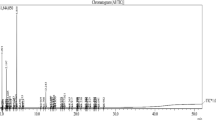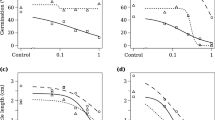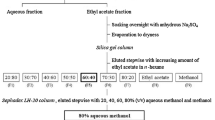Abstract
Water and solvent extracts from the aerial tissues ofCentaurea maculosa, spotted knapweed, inhibited the root growth of lettuce. Column chromatography and lettuce bioassay of a chloroform extract led to the isolation of cnicin, a sesquiterpene lactone. Pure cnicin was bioassayed at 0, 1, 2, 4, 6, 8, and 10 mg/5 ml water with lettuce, created wheatgrass, bluebunch wheatgrass, rough fescue, western larch, lodgepole pine, and spotted knapweed. Germination was inhibited at one or more concentrations for all species except lodgepole pine and spotted knapweed. Growth, particularly of the roots, was retarded between 1 and 4 mg of cnicin. Lettuce, bluebunch wheatgrass, and spotted knapweed were inhibited significantly at all concentrations tested.
Similar content being viewed by others
References
Abeysekera, B.F., Abramowsi, Z., andTowers, G.H.N. 1985. Chromosomal aberrations caused by sesquiterpene lactones in Chinese hamster ovary cells.Biochem. Syst. Ecol. 13:365–369.
Amo, S.D., andAnaya, A.L. 1978. Effect of some sesquiterpenic lactones on the growth of certain secondary tropical species.J. Chem. Ecol. 4:305–313.
Asakawa, Y., andTakemoto, T. 1979. Sesquiterpene lactones ofConocephalum conicum.Phytochemistry. 18:285–288.
Belles, W.S.,Wattenbarger, D.W., andLee, G.A. 1980. Effects of various herbicide treatments and subsequent fertilization on spotted knapweed control and forage production in Bonner County. Western Society Weed Science Research Progress Report, pp. 57–60.
Blakeman, J.P., andAtkinson, P. 1979. Antimicrobial properties and possible role in host-pathogen interactions of parthenolide, a sequiterpene lactone isolated from glands ofChrysanthemum parthenium.Physiol. Plant Pathol. 15:183–192.
Bucher R.F. 1984. The potential cost of spotted knapweed to Montana range users. Cooperative Extension Service Bull. 1316, Montana State University, Bozeman.
Burnett, W.C., Jr., Jones, S.B., Jr., Mabry, T.J., andPadolina, W.G., 1974. Sesquiterpene lactones—insect feeding deterrents inVernonia.Biochem. Syst. Ecol. 2:25–29.
Burnett, W.C., Jones, S.B., andMabry, T.J. 1977. Evolutionary implications of sesquiterpene lactones inVernonia (Compositae) and mammalian herbivores.Taxon 26:203–207.
Burnett, W.C., Jr., Jones, S.B., Jr., andMabry, T.J. 1978. The role of sesquiterpene lactones in plant-animal coevolution, pp. 233–257,in J.B. Harborne (ed.). Biochemical Aspects of Plant and Animal Coevolution. Academic Press, London.
Cavallito, C.J., andBailey, J.H. 1949. An antibacterial principle fromCentaurea maculosa.J. Bacterial. 57:207–212.
Chicoine, T.K. 1984. Spotted knapweed (Centaurea maculosa L.) control, seed longevity and migration in Montana. MS thesis, Montana State University, Bozeman.
Dalvi, R.R., Singh, B., andSalunkhe, D.K. 1971. A study on phytotoxicity of alantolactone.Chem.-Biol. Interact. 3:13–18.
Dupuis, G., Benezra, C., Schlewer, G., andStampf, J.L. 1980. Allergic contact dermatitis to α-methylene-7-butyrolactones.Mol. Immunol. 17:1045–1051.
Elissalde, M.H., Ivie, G.W., Rowe, L.D., andElissalde, G.S. 1983. Considerations of the structure of sesquiterpene lactones on biological activity: Influence of the α-methylene-γ-lactone moiety on mast cell degranulation.Am. J. Vet. Res. 44:1894–1897.
Fischer, N.H., andQuijano, L. 1985. Allelopathic agents from common weeds, pp. 133–147,in A.C. Thompson (ed.). The Chemistry of Allelopathy, ACS Symposium Series 268. American Chemical Society, Washington, D.C.
Fletcher, R.A., andRenney, A.J. 1963. A growth inhibitor found inCentaurea spp.Can. J. Plant Sci. 43:475–481.
French, R.A., andLacey, J.R. 1983. Knapweed: Its cause, effect and spread in Montana. Cooperative Extension Service Circular 307, Montana State University, Bozeman.
Garciduenas, M.R., Domingeuz, X.A., Fernandez, J., andAlanis, G. 1972. New growth inhibitors fromParthenium hysterophorus.Rev. Latinoam. Quim. 2:52–53.
Geppert, B., Drozdz, B.,Kielczewski, M., andHolub, M. 1983. Sesquiterpene lactones. XXIII. Isolation of sesquiterpene lactones fromCentaurea L. species.Acta Soc. Bot. Pol. 52:23–34.
Gonzalez, A.G., Darias, V., Alonso, G., Boada, J.N., andFeria, M. 1978. Cytostatic activity of sesquiterpene lactones from Compositae of the Canary Islands.Planta Med. 33:356–359.
Hall, I.H., Lee, K.H., Starnes, C.O., Muraoka, O., Sumida, Y., andWaddell, T.G. 1980a. Antihyperlipidemic activity of sesquiterpene lactones and related compounds.J. Pharm. Sci. 69:694–697.
Hall, I.H., Starnes, C.O., Jr., Lee, K.H., andWaddell, T.G. 1980b. Mode of action of sesquiterpene lactones as antiinflammatory agents.J. Pharm. Sci. 69:537–543.
Harmatha, J., andNawrot, J. 1984. Comparison of the feeding deterrent activity of some sesquiterpene lactones and a lignan lactone towards selected insect storage pests.Biochem. Syst. Ecol. 12:95–98.
Harris, P., andCranston, R. 1979. An economic evaluation of control methods for diffuse and spotted knapweed in western Canada.Can. J. Plant. Sci. 59:375–382.
Jones, S.B., Jr., Burnett. W.C. Jr., Coile, N.C., Mabry, T.J., andBetkouski, M.F. 1979. Sesquiterpene lactones ofVernonia—Influence of glaucolide-A on the growth rate and survival of lepidopterous larvae.Oecologia 39:71–77.
Kanchan, S.D., andJayachandra. 1979a. Allelopathic effects ofParthenium hysterophorus L. I. Exudation of inhibitors through roots.Plant Soil 53:27–35.
Kanchan, S.D., andJayachandra. 1979a. Allelopathic effects ofParthenium hysterophorous L. I. Exudation of inhibitors through roots.Plant Soil 53:27–35.
Kanchan, S.D., andJayachandra. 1979b. Allelopathic effects ofParthenium hysterophorus L. III. Inhibitory effects of the weed residue.Plant Soil 53:37–47.
Kanchan, S.D., andJayachandra 1980. Allelopathic effects ofParthenium hysterophorus L. Part IV. Identification of inhibitors.Plant Soil 55:67–75.
Lacey, J.R. 1983. A complete takeover by knapweed in 2001?Mont. Farmer-Stockman 70:32–34.
Lee, K.H., Huang, E.S., Piantadosi, C., Pagano, J.S., andGeissman, T.A. 1971. Cytotoxicity of sesquiterpene lactones.Cancer Res. 31:1649–1654.
Lee, K.H., Hall, I.H., Mar, E.C., Starnes, C.O., Elgebaly, S.A., Waddell, T.G., Had-graft, R.I., Ruffner, C.G., andWeidner, I. 1977a. Sesquiterpene antitumor agents: Inhibitors of cellular metabolism.Science 196:533–536.
Lee, K.H., Ibuka, T., Wu, R.Y., andGeissman, T.A. 1977b. Structure-antimicrobial activity relationships among the sesquiterpene lactones and related compounds.Phytochemistry 16:1177–1181.
Lee, K.H., Ibuka, T., Sims, D., Muraoka, O., Kiyokawa, H., Hall, I.H., andKim, H.L. 1981. Antitumor agents. 44. Bis(helenalinyl) esters and related derivatives as novel potential anti leukemic agents.J. Med. Chem. 24:924–927.
Liou, Y.F., Hall, I.H., Lee, K.H., Williams, W.L., Jr., andChaney, S.G. 1983. Investigation of sesquiterpene lactones as protein synthesis inhibitors of p-388 lymphocytic leukemia cells.Biochim. Biophys. Acta 739:190–196.
Mabry, T.J., andGill, J.E., 1979. Sesquiterpene lactones and other terpenoids, pp. 501–537, in G.A. Rosenthal and D.H. Janzen (eds.). Herbivores: Their Interaction with Secondary Plant Metabolites. Academic Press, New York.
Maddox, D.M. 1979. The knapweeds: Their economics and biological control in the western states,U.S.A. Rangelands 1:139–141.
Mandava, N.B. 1985. Chemistry and biology of allelopathic agents, pp. 33–54,in A.C. Thompson (ed.). The Chemistry of Allelopathy, ACS Symposium Series 268. American Chemical Society, Washington, D.C.
Marchant, Y.Y., Balza, F., Abeysekera, B.F., andTowers, G.H.N. 1984. Molluscicidal activity of sesquiterpene lactones.Biochem. Syst. Ecol. 12:285–286.
McCahon, C.B., Kelsey, R.G., Sheridan, R.P., andSharizadeh, F. 1973. Physiological effects of compounds extracted from sagebrush.Bull. Torrey Bot. Club. 100:23–28.
Muir, A.D., andMajak, W. 1983. Allelopathic potential of diffuse knapweed (Centaurea diffusa) extracts.Can. J. Plant Sci. 63:989–996.
Picman, A.K. 1984. Antifungal activity of sesquiterpene lactones.Biochem. Syst. Ecol. 12:13–18.
Picman, J., andPicman, A.K. 1984a. Autotoxicity inParthenium hysterophorus and its possible role in control of germination.Biochem. Syst. Ecol. 12:287–292.
Picman, A.K., andPicman, J. 1984b. Effect of selected pseudoguaianolides on survival of the flour beetle,Tribolium confusum.Biochem. Syst. Ecol. 12:89–93.
Picman, A.K., andTowers, G.H.N. 1983. Antibacterial activities of sesquiterpene lactones.Biochem. Syst. Ecol. 11:321–327.
Politis, M.J. 1946a. Sur la formation des glucosides amers dans les poils glanduleux de certaines plantes.C.R. Acad. Sci. (Paris) 222:910–911.
Politis, J. 1946b. Sur le mode de formation des essences dans certains poils glanduleux.C.R. Acad. Sci. (Paris) 222:1244–1245.
Rodriguez, E., Towers, G.H.N., andMitchell, J.C. 1976. Biological activities of sesquiterpene lactones.Phytochemistry. 15:1573–1580.
Rustaiyan, A., Niknejad, A., andAynehchi, Y. 1982. Chemical constituents ofCentaurea brugueriana.Planta Med. 44:185–186.
Samek, Z., Holub, M., Herout, V., andSorm, F. 1969. Revision of the structure of cnicin.Tetrahedron Lett. 34:2931–2934.
Schirman, R. 1981. Seed production and spring seedling establishment of diffuse and spotted knapweed.J. Range Manage. 34:45–47.
Schirman, R. 1984. Seedling establishment and seed production of diffuse and spotted knapweed, pp. 7–10, Proceedings of the Knapweed Symposium, Cooperative Extension Service Bull. 1315, Montana State University, Bozeman.
Seaman, F.C. 1982. Sesquiterpene lactones as taxonomic characteristics in the Asteraceae.Bot. Rev. 48:121–595.
Spencer, G.F., Wolf, R.B., andWeisleder, D. 1984. Germination and growth inhibitory sesquiterpenes fromIva axillaris seeds.J. Nat. Prod. 47:730–732.
Spring, O., andHager, A. 1982. Inhibition of elongation growth by two sesquiterpene lactones isolated fromHelianthus annuus L.Planta 156:433–440.
Spring, O., Kupka, J., Maier, B., andHager, A. 1982. Biological activities of sesquiterpene lactones fromHelianthus annuus: Antimicrobial and cytotoxic properties; influence on DNA, RNA, and protein synthesis.Z. Naturforsch. 37:1087–1091.
Stevens, K.L. 1982. Sesquiterpene lactones fromCentaures repens.Phytochemistry 21:1093–1098.
Stevens, K.L., andMerrill, G.B. 1985. Sesquiterpene lactones and allelochemicals fromCentraurea species, pp. 83–98,in A.C. Thompson (ed.). The Chemistry of Allelopathy, ACS Symposium Series 268. American Chemical Society, Washington, D.C.
Strang, R.M., Lindsay, K.M., andPrice, R.S. 1979. Knapweeds: British Columbia's undesirable aliens.Rangelands 1:141–143.
Suchy, M., andHerout, V. 1962. On terpenes. CXXXVI. Identity of the bitter principle fromCentaurea stoebe (L.) Sch. et Thell. with cnicin.Collect. Czech. Chem. Commun. 27:1510–1512.
Suchy, M., Benesova, V., Herout, V., andSorm, F. 1959. Contribution on the structure of cnicin, the bitter principle fromCnicus benedictus L.Tetrahedron Lett. 10:5–9.
Suchy, M., Herout, V., andSorm, F. 1962. On terpenes. CXLI. Absolute configuration of cnicin and scabiolide.Collect. Czech. Chem. Commun. 27:2398–2403.
Suchy, M., Samek, Z., Herout, V., andSorm, F. 1965. On terpenes. CLXXV. Revision of structure of artiopicrin, cnicin and scabiolide.Collect. Czech. Chem. Commun. 30:3473–3477.
Van Aswegen, C.H., Potgieter, D.J.J., andVermeulen, N.M.J. 1982. Site of respiratory inhibition by sesquiterpene lactones fromGeigeria.S. Afr. J. Sci. 78:125–127.
Vanhaelen-Fastré, R. 1972. Activities antibiotique et cytotoxique de la cnicine, isolee deCnicus benedictus L.J. Pharm. Belg. 27:683–688.
Vanhaelen-Fastré, R., andVanhaelen, M. 1976. Activite antibiotique et cytotoxique de la cnicine et de ses produits d'hydrolyse.Planta Med. 29:179–189.
Wagner, H. 1977. Pharmaceutical and economic uses of the Compositae, pp. 411–433,in V.H. Heywood, J.B. Harborne, and B.L. Turner (eds.). The Biology and Chemistry of the Compositae, Vol. I. Academic Press, London.
Watson, A.K., andRenney, A.J. 1974. The biology of Canadian weeds. 6.Centaurea diffusa andC. maculosa.Can. J. Plant Sci. 54:687–701.
Woynarowski, J.M., andKonopa, J. 1981. Inhibition of DNA biosynthesis in HeLa cells by cytotoxic and antitumor sesquiterpene lactones.Mol. Pharmacol. 19:97–102.
Woynarowski, J.W., Beerman, T.A., andKonopa, J. 1981. Induction of deoxyribonucleic acid damage in HeLa S3 cells by cytotoxic and antitumor sesquiterpene lactones.Biochem. Pharmacol. 30:3005–3007.
Author information
Authors and Affiliations
Rights and permissions
About this article
Cite this article
Kelsey, R.G., Locken, L.J. Phytotoxic properties of cnicin, a sesquiterpene lactone fromcentaurea maculosa (spotted knapweed). J Chem Ecol 13, 19–33 (1987). https://doi.org/10.1007/BF01020348
Received:
Revised:
Issue Date:
DOI: https://doi.org/10.1007/BF01020348




